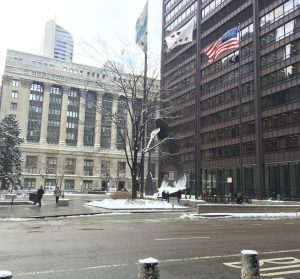The Shedd Aquarium addressed the threat of a destructive Asian carp infestation last week by hosting a panel discussion with experts from the Midwest region. They discussed the invasive species threat, which is being debated by the U.S. Supreme Court Friday.
Panelists Reuben Keller, David Lodge, Duane Chapman, Bill Boden, Josh Ellis and David Uldrich shared disturbing details at the April 6 event, describing damage that has been done by Asian carp in other rivers — damage that could be done in the Great Lakes, too, if strict measures aren’t taken to prevent a full-fledged invasion.
The carp have been present in the Midwest since the 1970s, when they were brought to Arkansas for use as “cleaning agents” on fish farms. The fish escaped those farms and ventured up the Mississippi River and into Chicago’s waterways, growing in size and quantity along the way.
Lodge, a professor of biological sciences at the University of Notre Dame, reiterates that the Asian carp aren’t just statewide threats, but also can become infamous in the entire region’s water systems.
“This canal connects two of the greatest waterways (and) river basins of North America,” Lodge said, “one being the Mississippi river water basin … and the other, the Great Lakes and St. Lawrence Seaway. The Chicago area canal connects those two.”
This possible catastrophe has driven the Great Lakes states of Illinois, Ohio, Indiana, Michigan, Wisconsin and New York to take Illinois to the U.S. Supreme Court in an effort to force them to close the locks that are in Chicago’s waterways leading to Lake Michigan.
The states claim that if the carp reach the lake, the ecological devastation would be great and would damage all these states’ economic and environmental health.
Lodge also stressed that there are other invasive species threatening the waterways.
Methods to prevent the continuous spread of carp have ranged from biological to mechanical means. Some have shown upsides in the containment and extermination of the invasive species, but haven’t completely eradicated the problem.
“Engineering will not be the only solution to biological control,” said Boden. “It’s got to be a multi-tier approach. Management options. USGS (United States Geological Survey). Engineering solutions. It’s going to require all the tricks we have in our tool kit.”
Boden also reiterated that “it’s the entire Great Lakes’ problem. There is an interconnecting body of water within each of the states.”
Ellis, an expert on the operation and effects of the Chicago waterway system, explained that the system has a huge impact on the surrounding areas.
“The city of Chicago itself has 4,200 miles of pipes that move Lake Michigan water around. That’s just drinking water … that’s an immense system.”
Ellis also made the audience ponder the idea of re-reversing the Chicago River, improving the treatment of Chicago’s sewage and discharging it back into Lake Michigan.
“What if we first improve our waste water treatment to Great Lakes standards so that water could go back to the lakes?” he said. “There’s lots of chemical opportunities, biological opportunities. Allow treated effluent to go back into the lake.”
Ellis suggested thinking “about all of our 21st century goals for the waterway system and not just the carp and not just the freight and not just the tour boats. If we work with our regional harbors, if we work with the Army Corps, if we work with the other states, we can make a difference.”
Uldrich demonstrated the ferocity of the species, showing a picture of how his work studying “invasive species can be a very up-front and personal activity.
He showed a picture of his initiation into the Great Lakes Fishery Commission, which entailed hanging an eel-like sea lamprey off his arm. The picture, which received loud gasps from the onlookers, was a blunt statement that cures to all the waterway’s problems need to be implemented as soon as possible.

![Reblog this post [with Zemanta]](http://img.zemanta.com/reblog_c.png?x-id=224c64cf-3657-4227-b241-aa2c0bbbc796)










Be First to Comment